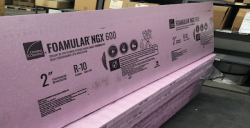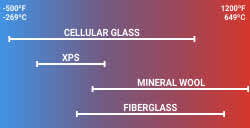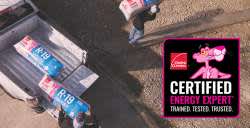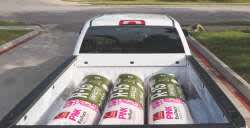
- Fire
- Industrial
- Blog
Mitigating LNG pool fires using passive systems
Blog in Brief
Liquid natural gas (LNG) pool fires are an industry concern and a danger for any facility storing, processing or handling flammable materials. Regulations that dictate facility design anticipate the potential for negative effects from pool fires, including thermal radiation and the potential movement of clouds of invisible, vaporized, flammable gas. Facilities working with LNG can plan and prepare for these fires, but these determinations can lead to required exclusion zones or increase installation costs. Passive fire mitigation systems may be used within a facility’s design to mitigate these risks as a component of an overarching safety plan. With this in mind, Owens Corning has developed two different passive fire systems – the FOAMGLAS® Pool Fire Suppression system (PFS Gen 2) and the FOAMGLAS® Cryo Spill™ system. The FOAMGLAS® PFS™ system is predominantly comprised of FOAMGLAS® cellular glass insulation and can be used to reduce the rate of vaporization and thermal radiation. The FOAMGLAS® Cryo Spill™ system also employs FOAMGLAS® cellular glass insulation and can help protect the concrete and steel used in pit construction, maintaining load-bearing performance. When combined, these two passive response mechanisms can reduce the boil off of spilled LNG and potential heat generated during a fire event.
Mitigating LNG pool fires using passive systems
An important consideration for facilities that handle, process or store cryogenic products like liquid natural gas (LNG) is how to address potential hazards created if a spill occurs. There are three main challenges for cryogenic spill containment. First, evaluating the potential for thermal shock to damage the steel and concrete used to construct the spill pit. Second, minimizing the vaporization or boil off of liquid hydrocarbons. Third, reducing the radiant heat generated if the spilled material ignites.

Figure 1 – When liquid natural gas spills and ignites, the spill pool can become a self-propagating fire as the heat generated increases the amount of fuel available to burn.
Due to the cryogenic temperatures at which materials like LNG are stored, protection of the containment pit walls and floor from thermal shock is an important consideration. LNG is stored at approximately -160°C (-256°F), which is cold enough to cause micro-fracturing in concrete it comes into contact with. This can compromise the load bearing capacity of concrete within impoundment pit walls and floors. In addition, steel and stainless steel may become brittle and less ductile in nature at sub-freezing temperatures, meaning any supporting steel structures or fixtures may experience a reduction in load-bearing capacity in the event of a spill. Low-temperature stainless steel can also be expensive to use compared to typical construction materials.
Another important design consideration is to limit the vaporization rate of cryogenic liquids within a containment pit. Should a spill occur, low-temperature LNG will begin to rapidly heat up and vaporize due to surrounding ambient conditions. These invisible gases are flammable within certain concentrations in the air (5-15%). This means that gases may become a fire hazard either around the containment pit or at some location downwind from it. By limiting heat flux into spilled cryogenic liquids, this vaporization rate can be reduced, minimizing the available flammable material within the area.
If these flammable gases were to ignite, it becomes important to limit the radiant heat generated from the resulting fire so the heat itself doesn’t exacerbate the problem. Heat from active flames will expedite the process of further gas vaporization. This, in turn, will generate more fuel for the fire, which increases the heat and so on.
The National Fire Protection Association Standard 59A – Standard for the Production, Storage and Handling of LNG – provides guidelines for the location, design, construction, security and operation of LNG storage and production facilities. The standard can also be used to supersede regulatory approvals or to support site layout and size changes needed for exclusion zones. When enforcing the standard at a proposed LNG production or storage facility, officials may consider a passive fire mitigation system in the approval process.
With these three previously discussed challenges in mind, Owens Corning developed two different passive fire response systems – the FOAMGLAS® Pool Fire SuppressionTM system (PFS Gen 2) and the FOAMGLAS® Cryo Spill™ system.
System 1 – FOAMGLAS® PFS™ Generation 2
FOAMGLAS® is a rigid, lightweight and buoyant insulation made of individual, closed cells of glass. The material is nonabsorbent, impervious to moisture or vapor and has a high compressive strength. It has a wide temperature use range, is noncombustible, does not produce toxic smoke and is chemically inert, making it ideal for use in fire-stopping activities.

Figure 2 – FOAMGLAS® cellular glass insulation has several characteristics that make it well suited for use in fire containment systems.
FOAMGLAS® PFS™ Generation 2 makes use of several properties of FOAMGLAS® insulation to help reduce vaporization in the event of a spill and limit thermal radiation if a pool fire occurs. The low-maintenance system is designed to be installed and left in place until needed. It is self-deployed and can also be combined with other passive or active safety programs that may already be installed.

Figure 3 – Should a spill occur, the FOAMGLAS® PFS™ system forms a cap over the spilled liquid, reducing thermal radiation and boil off of LNG.
The FOAMGLAS® PFS™ Generation 2 system consists of a series of FOAMGLAS® blocks coated in silicone and cladded in stainless steel. The resulting modules are then connected using stainless steel bridges and screws. This establishes a rigid system of interconnected modules that can sit at the bottom of a spill pit until needed. When LNG from a spill or leak enters the pit, the buoyancy of FOAMGLAS® causes the modules to rise to the top, forming a cap and helping to insulate the liquid from external heat sources, such as the sun or ambient air. The patented system also acts to reduce the amount of heat that transfers back into the pool in the event of a fire, which also helps limit thermal radiation. In testing, this system was shown to reduce radiant heat of hydrocarbon pool fires within a containment pit by approximately 80%.

Figure 4 – The FOAMGLAS® PFS™ Generation 2 system is comprised of attached modules of cellular glass insulation. Optional legs can be added under the insulating blanket if regional precipitation is a concern.
The same modules are used every time the system is installed, but no two pits are identical. Every spill pit must be measured and a custom design created to address any gaps, obstructions or unique properties. Once the pit has been measured and a layout plan for the insulating modules completed, the blocks are sent to the location, installed according to the plan and connected.
System 2 – FOAMGLAS® Cryo Spill™ system
As previously mentioned, concrete and structural steel will experience changes in structure when exposed to critically low temperatures. At sub-freezing temperatures, concrete may experience contraction of the solid network or expansion of internal moisture as it freezes, either of which may cause microfractures to occur. At these temperatures, steel and stainless-steel components can also become brittle and less ductile in nature. All of these phenomena can contribute to a reduction in load-bearing capacity for structural elements, which brings an importance to the consideration of thermal shock protection.
The FOAMGLAS® Cryo Spill™ system is another passive response system created to help mitigate damage to the pit itself should an LNG or other cryogenic liquid spill occur. The system provides thermal shock protection for structural elements of a containment pit while also limiting heat flux into cryogenic liquids.
There are multiple ways to configure the system, as it can be installed using a single or double layer of insulation. The system is typically installed by applying adhesive to blocks of insulation, then lining the block to pit walls and floors. Anchors can also be added to further secure the insulating layer. More adhesive is used to add a second layer of insulation, which is then coated to protect against UV and weather. A metal flashing is also recommended around the top edge of the pit to reduce the risk of water entering the system.
Combining systems to mitigate pool fires
In addition to designing the two FOAMGLAS® systems to work independently, they also can be combined within the same containment to achieve a greater level of mitigation. To demonstrate this improvement, an energy analysis calculation was run comparing the vaporization rates with and without these systems in place.
The example pit used displays the following characteristics:
The LNG containment pit is 4.57m x 4.57m x 3.05m (15 ft x 15 ft x10 ft) and has 15cm (6 in.) concrete walls. The ground temperature is 20°C (68°F), the air temperature is 24°C (75°F) and the LNG spilled is -160°C (-256°F). In these conditions, the LNG heat of vaporization is 512kj/kg (220btu/lb.).
When neither passive protective system is used, the total heat gain from solar load, ambient air, and transfer through the concrete is 32.5kW (110,803 btu/hr.) and the boil off is about 3.81kg/min (8.4lb/min).

Figure 5 – An unprotected spill pit has few ways to limit heat gain in spilled LNG or reduce the rate of vaporization.
When just the FOAMGLAS® PFS™ system is added – meaning the spill pit is capped with metal-cladded blocks of FOAMGLAS® cellular glass insulation – both heat gain and boil off are reduced. Heat gain drops to 9.04kW (30,856 btu/hr.) and the boil off is 1.06kg/min (2.34lb/min).

Figure 6 – Capping the spilled liquid with the FOAMGLAS® PFS™ system helps reduce the rate of vaporization and lowers flame height in the event of ignition.
However, when the FOAMGLAS® PFS™ system is combined with 50mm of the FOAMGLAS® Cryo Spill™ system – meaning the pit itself is insulated and the spilled LNG is capped with insulation – there is an 88% reduction in the amount of LNG that boils off. Total heat gain is lowered to 4.09kW (13,943 btu/hr.) and boil off drops to 0.48kg/min (1.06lb/min).

Figure 7 – Applying both FOAMGLAS® passive response systems can reduce LNG boil off by up to 88%, limiting the amount of fuel that a spill pool fire can access.
Conclusion
Both FOAMGLAS®-based passive response systems work by addressing the main hazards present when a spill occurs – helping to reduce vaporization or boil off of the flammable material, limiting thermal radiation generated and protecting spill pit elements from thermal shock damage. When used together, they can provide increased protection against hazardous concerns associated with cryogenic liquid spills within facilities.
For more information on how the FOAMGLAS® PFS™ and the FOAMGLAS® Cryo Spill™ systems work and are installed, a video is available here or visit: https://www.owenscorning.com/en-us/insulation/products/pfs-gen-2 and https://www.owenscorning.com/en-us/insulation/industrial/blog/cryogenic-spillage-protection
Related Articles

Fire • Industrial • BlogCombustible Liquids in Insulation

Fire • Industrial • BlogThe Behavior of Industrial Insulation in Case of Fire

Fire • Industrial • WebinarPassive Fire Protection Systems Webinar

Fire • Industrial • BlogMitigating LNG pool fires using passive systems

Fire • Industrial • BlogFire testing takeaways to consider when selecting insulation for fire protection
Jump to a Solution Suite
Jump to a Solution Suite







